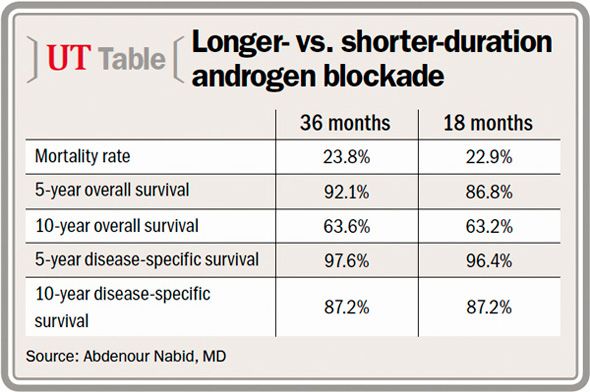Article
Shorter-duration androgen blockade found efficacious
Author(s):
Patients with high-risk prostate cancer who undergo 18 months of androgen blockade live as long as those who have 36 months of treatment, according to results of a recent phase III study.
Orlando, FL-Patients with high-risk prostate cancer who undergo 18 months of androgen blockade live as long as those who have 36 months of treatment, according to results of a recent phase III study.
“Our study shows that androgen blockade can be safely reduced from 36 months to 18 months without compromising outcomes,” said first author Abdenour Nabid, MD, associate professor at Centre Hospitalier Universitaire de Sherbrooke, Sherbrooke, Canada. “We hope that these results will convince doctors that they can stop hormone therapy after 1.5 years instead of 2 to 3 years.”
The optimal duration of androgen blockade therapy remains controversial. Several studies have looked at this question, mainly because the side effects of this therapy have a negative impact on quality of life.
“Side effects can include a wide range of physical, mental, and emotional side effects in men, including ‘the castration syndrome,’ which entails hot flashes, loss of libido, loss of erectile function; other side effects include weight gain, loss of bone density, loss of muscle mass, and depression. These side effects worsen with longer duration of therapy and make life miserable for most men,” said Dr. Nabid, who presented the findings at the Genitourinary Cancers Symposium in Orlando, FL.

The phase III study was conducted at 10 centers in Quebec and enrolled 630 patients with node-negative, high-risk prostate cancer treated with radiotherapy to the pelvic area and prostate bed. Men were randomized to 18 months of androgen blockade versus 36 months of androgen blockade (biculatamide [Casodex] 1 month plus goserelin [Zoladex] every 3 months) initiated 4 months before radiotherapy and given during and after radiation.
Patient characteristics were well balanced between the two arms. Patients were high-risk: T3-T4 disease, PSA >20 ng/mL, and Gleason score >7 at diagnosis. Median age was 71 years (range, 18-80 years).
At a median follow-up of 77 months, no difference between the two groups was seen for biochemical failure, metastasis, bone-only metastasis, and cause of death. Mortality rates were 23.8% (76 patients) in the longer-duration hormone therapy arm versus 22.9% (71 patients) in the shorter-duration arm (p=.802). Of 147 deaths, 116 were deemed unrelated to prostate cancer.
Similar survival results seen across groups
Five-year overall survival (OS) was 92.1% for the longer-duration arm versus 86.8% for the shorter-duration arm (p=.052), and 10-year OS was 63.6% versus 63.2%, respectively (p=.429). Five-year disease-specific survival was 97.6% for the longer-duration arm versus 96.4% for the shorter-duration arm (p=.473); 10-year disease-specific survival rates were 87.2% in both arms.
The main cause of death was second cancer (7.3% of patients); 4.9% died of prostate cancer, and 4.4% of cardiovascular disease.
In a multivariate analysis, age was the only significant factor predicting overall survival (p<.001).
“In localized prostate cancer patients treated with radiation therapy and androgen blockade, treatment with 18 months of androgen blockade is safe. This could represent a threshold for no further gain. Eighteen months does the job,” Dr. Nabid said.
If the full peer review publication of this study supports the findings presented at the GU Cancers Symposium, this study could change the standard of care to “at least 24 months and perhaps 18 months,” said Bruce Roth, MD, professor of medicine at Washington University, St Louis, who moderated the press presentation of the study.UT

















